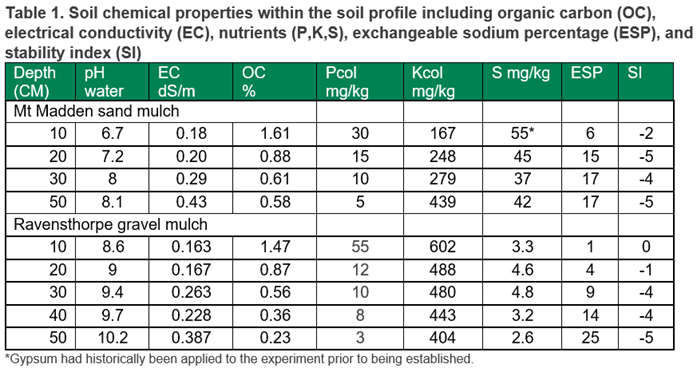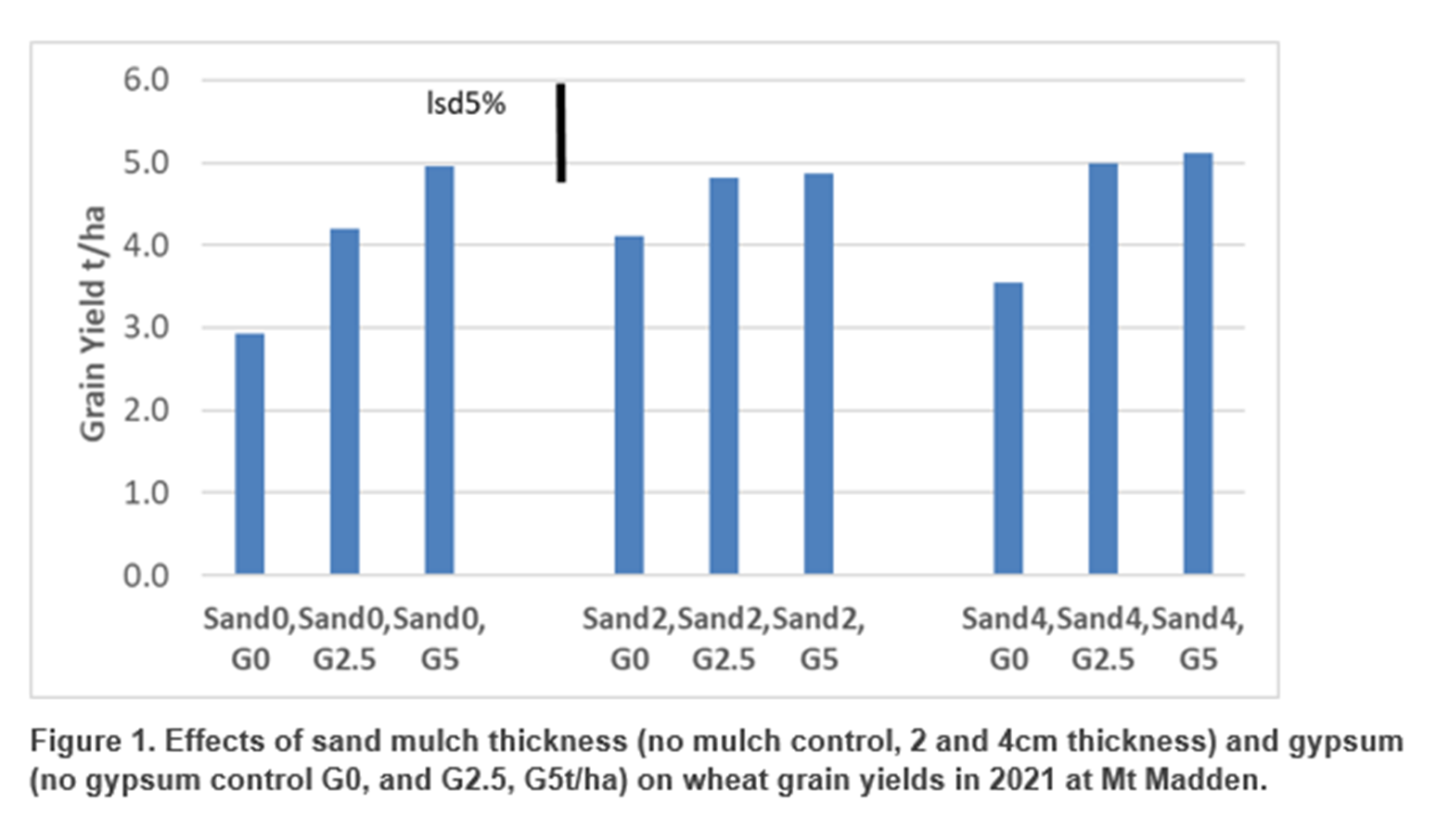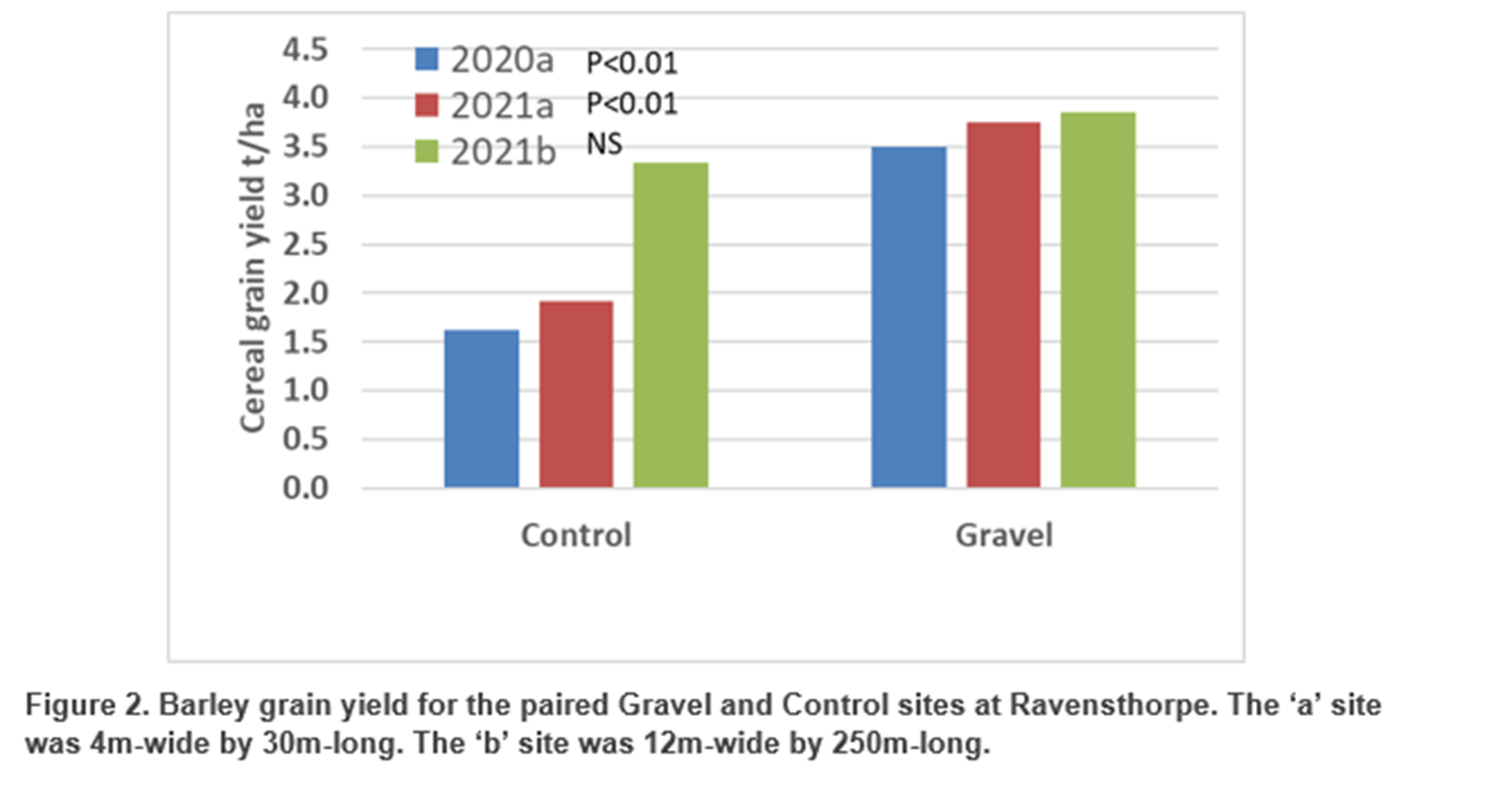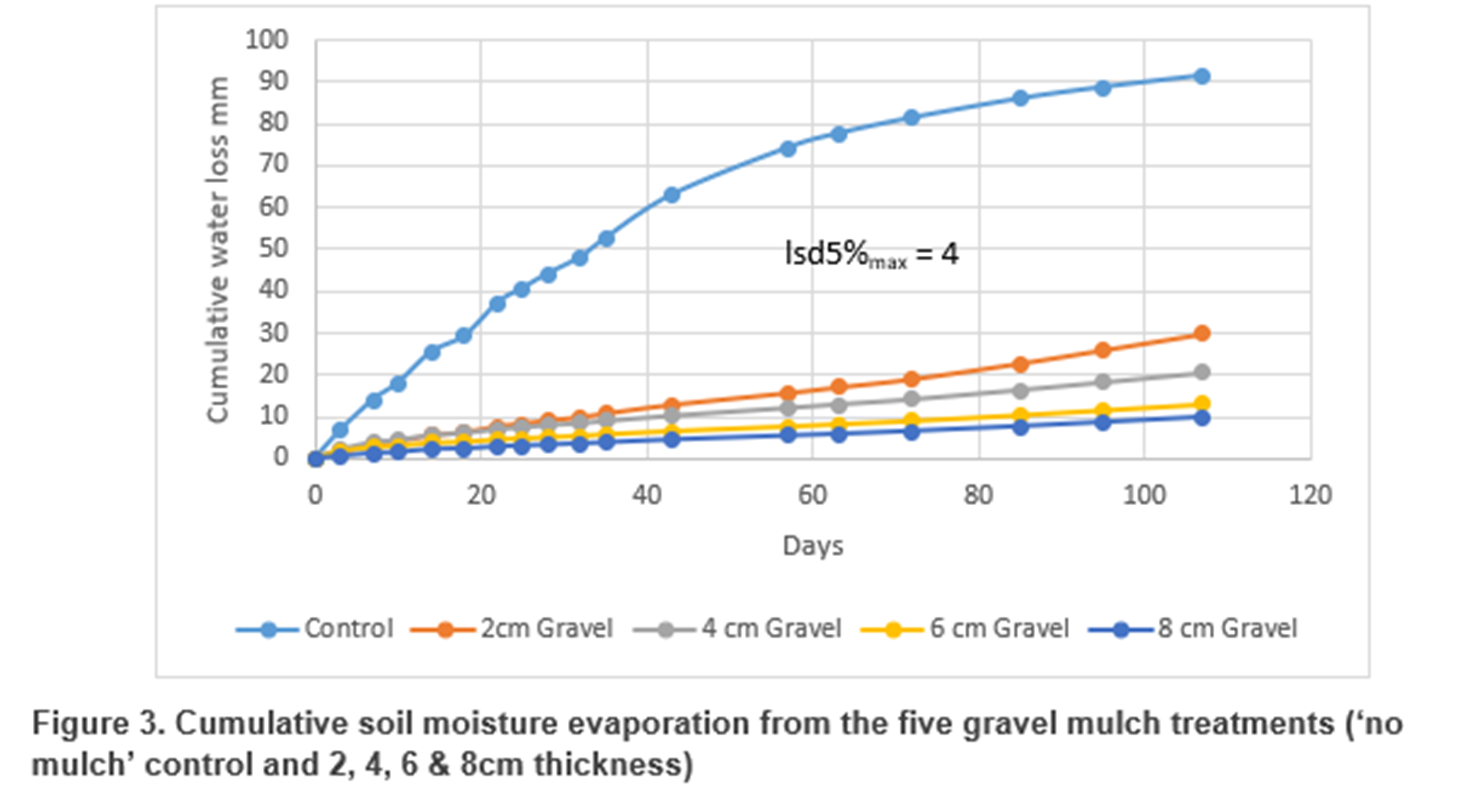Mineral mulches improve water relations and yields on sodic clay soils
Mineral mulches improve water relations and yields on sodic clay soils
Author: David Hall, Peter Daw, Lloyd Burrell, Wayne Parker and Rushna Munir (Department of Primary Industries and Regional Development) | Date: 10 Mar 2022
Key messages
- As much as 40% of rainfall is lost through soil evaporation with sodic clay soils (heavy soils) in low-rainfall environments especially prone to high rates of soil evaporation due to poor water infiltration.
- Adding 2cm of gravel mulch significantly reduced soil evaporation by 60mm over 107 days in a glasshouse trial.
- Field trials have shown that on clay soils, unincorporated gravel and sand applied to the surface as mulches can increase yield by 0.5–1t/ha in non-waterlogged soils.
- The sand or gravel mulch should not be incorporated.
Aims
To increase crop production on sodic clay soils by improving soil water infiltration and retention.
Introduction
Up to 40% of rainfall can be lost through surface evaporation in dryland farming systems in WA. Evaporation is exacerbated when a high percentage of soil water is stored near the soil surface. Sodic clay soils often have impeded water infiltration and are in environments with low rainfall and high evaporative demand. Therefore, these soils are more susceptible to water loss through soil evaporation.
Organic and mineral mulches (sand, gravel, rock) are widely used in domestic gardens and intensive horticulture to reduce soil evaporation and physically protect the surface soil structure. Sand and rock mulches have been shown to increase productivity of sodic soils in China, Oman and Pakistan. However, their use in broadscale dryland cropping in Australia has not been investigated.
This paper details the results of three farm-scale trials near Ravensthorpe, Western Australia, in 2020 and 2021, which were designed to assess the impact of gravel and sand mulches on crop production. Also explored, was the relationship between gravel mulch thickness and soil water evaporation in a glasshouse experiment in 2021.
Method
The sand mulching experiment at Mt Madden involved three sand mulch treatments (a ‘no mulch’ control and two sand mulch treatments of 2 and 4cm) and three rates of gypsum (a ‘no gypsum’ control and 2.5 and 5t/ha) in a split-plot design with three replicates on an alkaline loamy duplex soil (Table 1). Each plot was 12m-wide and 200m-long. A belt spreader was used to top dress the sand, which was obtained from a neighbouring paddock in March 2020. Gypsum treatments were not applied until March 2021. The site was sown to canola (cv Hyola 559) in 2020 and wheat (cv Scepter) in 2021. Crop growth and yield were sampled manually.
The two gravel mulch experiments at Ravensthorpe involved single strips of gravel, 4m by 30m-long in 2020 and 12m-wide by 250m-long in 2021 with adjacent untreated ‘control’ strips. Both experiments were in the same paddock on a calcareous loamy duplex soil type (Table 1). The gravel was obtained on-farm and spread using a front-end loader. The gravel mulch was 3–6cm thick. A simple paired t-test was used to assess treatments compared to adjacent untreated controls.
The paddock was sown to wheat (cv Scepter) in 2020 and barley (cv Latrobe) in 2021. Crop growth and yield were sampled manually.
A glasshouse trial in Esperance in 2021 measured water loss from gravel mulch spread at five rates (no mulch control, 2, 4, 6 and 8cm thick). The soil was sieved to pass through 5mm mesh and the gravel 3–15mm mesh. For each treatment, four replicate pots were filled with the same calcareous loamy duplex soil found at the gravel experimental site. PVC pots (15cm diam x 40cm high) were filled so that the treated surfaces were level with the top of the pot. The pots were partially submerged into buckets of water and allowed to equilibrate for 24hrs. Once equilibrated, the pots were removed from the buckets to drain for 48hrs and then weighed regularly over the following 107 days. The pot positions were re-randomised at the end of each weighing. Temperature loggers were placed on top of the pots to identify any thermal differences between the treatments. Temperature was logged at
15-minute intervals over 12 days (20 August–3 September) to give 1152 recordings.
Soil chemical properties (Table 1) show that the soils at Mt Madden and Ravensthorpe were sodic (ESP > 6) below 10cm and 30cm respectively. The stability index (SI), where soils with more negative values are less stable, suggests that the soil from the sand mulch experiment is more prone to slaking and dispersion at the soil surface than the soil from the gravel mulch site. However, potentially both soils are equally dispersive at depth. Boron exceeded 10mg/kg beyond 30cm depth at both sites.

Results
Sand mulch experiment
Adding sand resulted in earlier establishment and phenological development of canola in 2020, which had a very dry start to the season. Canola emergence was significantly higher in the sanded treatments (20 plants/m2) than the control (12 plants/m2) in mid-May, however by mid-June there were no differences in plant numbers between the control (16 plants/m2) and the other treatments (17 plants/m2). Canola flowered earlier where sanded, however there were no differences between the treatments for final biomass or grain yield.
In 2021, both sand and gypsum treatments increased wheat yields. Sand increased wheat emergence by 40–50 plants/m2 above the control (126 plants/m2). There were also significantly more tillers (30–40 tillers/m2) in the sanded treatments than the control. Wheat grain yields were increased from 4.0t/ha (control) to 4.6t/ha (2cm sand mulch) and 4.5t/ha (4cm sand mulch). The gypsum treatments also resulted in significant yield increases. When averaged across the sanded treatments, the control (no gypsum) yielded 3.5t/ha while the 2.5 and 5t/ha gypsum treatments yielded 4.5 and 5t/ha. On this soil type, the grain yield response to gypsum was better than the highest rate of sand. This may reflect the wetter than normal seasonal conditions in 2021.

Gravel mulch field and glasshouse experiments
In both 2020 and 2021 significant increases in wheat and barley grain yields were measured at the Ravensthorpe ‘a’ site. Of the two sites, site ‘a’ was more responsive than site ‘b’ with average yield increases in 2021 being 1.8t/ha and 0.5t/ha respectively (Figure 2). The reasons for the yield difference between the two sites are not currently clear. Grain yield increased in response to higher tiller numbers and grain weights (2020) and higher tiller numbers (2021). When measured in early June 2021, gravel treatments had increased soil moisture (27%) to a depth of 15cm compared to the control (19%).

In the 2021 glasshouse trial, evaporation of soil moisture was significantly reduced by adding gravel mulch (Figure 3). Overall, the control resulted in 92mm of evaporation compared to 31, 20, 13 and 10mm for the 2, 4, 6 and 8cm gravel mulch treatments (Figure 3). Temperature loggers measured no difference in summed temperatures between the treatments over the 12 days. Summed dawn temperatures (3.30–5.30am) did not differ between the mulch treatments when measured in late August 2021.

The economics of sand and gravel mulches will depend on their availability on-farm and on transport and spreading costs. The sand and gravel mulches used in the experiments reported here were obtained on-farm. The rates used to generate the 2 and 4cm sand mulch treatments equate to 280 and 560t/ha. The sand was surface spread and not incorporated and after two years the sand had accumulated in the seeding furrows but the different rates were still visually different. Gravel spread at the 2cm depth is equivalent to 400t/ha while the 8cm depth is equivalent to 1600t/ha. Visually, the gravel does not appear to move or become incorporated as much as the sand.
Conclusions
We found that 2cm of sand/gravel can significantly increase crop yields, increase soil water storage and reduce evaporation from loam and clay textured soils. We suspect that the mineral mulch may also protect the surface soil structure from crusting and hard setting. The increase in water storage is therefore likely to be a combination of increased water infiltration and reduced soil evaporation.
We were unable to find thermal differences between the gravel mulch treatments and the control in the glasshouse experiment over either the whole 12-day period or at dawn. Further research with crops under field conditions is required to determine if there are any frost mitigation benefits from mineral mulches.
In highly dispersible clay soils, gypsum is more likely to be a more profitable remediation method. The application of this technique will be limited to farmers who have on-farm supplies of sands or gravels within carting distance of their clay soils.
Acknowledgments
Farmer cooperation by Pater Daw and Lloyd Burrell and technical support by Sam Richards and McKenzie Layman have been invaluable. The research undertaken is made possible by the significant funding contributions by growers through GRDC and the WA State Government through DPIRD.
Contact details
David Hall
Department of Primary industries and Regional Development, PMB50, Esperance, 6450
Ph: 0447914013
Email: david.hall@dpird.wa.gov.au.
Reviewed by: Glen Riethmuller, Tom Edwards and Dr. Ed Barrett-Lennard.
GRDC Project Code: DAW1902-001RTX,
